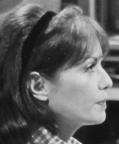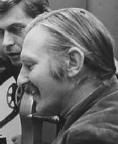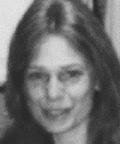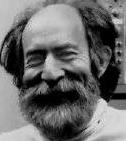ON THE FRUSTRATIONS OF COLLABORATING WITH ARTISTS Ken Knowlton, "former programmer" [Invited contribution to Carl Machover's column
|
| As a sociologist-on-training-wheels in belated adolescence,
I wrote an overview of art-and-technology. I explained in laypersons'
terms that computer art would come from artists, or from artists working
with programmers, not from programmers working alone, because |
| ... Both groups are creative, imaginative, intelligent,
energetic, industrious, competitive and driven. But programmers, in my
[vast world-embracing] experience, tend to be painstaking, logical, inhibited,
cautious, restrained, defensive, methodical, and ritualistic. Their exterior
actions are separated from their emotions by enough layers of logical
defenses that they can always say "why" they did something.
Artists, on the other hand, seem to be freer, alogical, intuitive, impulsive,
implicit, perceptive, sensitive, and vulnerable. They often do things
without being able to say why they do them, and one usually is polite
enough not to ask. ("Collaborations with Artists — a Programmer's
Reflections," Nake & Rosenfeld, GRAPHIC LANGUAGES, North Holland
Publishing Co. 1972). |
| Though widely quoted, this blast of adjectives I now see
as somewhat of a pothole in my life-long trail of paper. I later turned
it into a crater, compounding my presumptuousness by flailing at the pretensions
of "computer art" as a whole, because |
| (1) A work of Art must answer some of these questions: for
what technical or emotional problem is it a demonstration or search? ...
of what dialog is it a continuation? what does it state, demonstrate or
ask? from what personal attitude or social culture does it come? by what
syntax am I to parse it, by what semantics does it have meaning?
(2) ... every traditional medium makes possible an occasional expression of, for example, anxiety, remorse, tenderness, or nostalgia. In contrast to this, the most evocative quality of computer art to date [1986] seems, to me, to be antiseptic otherworldliness. (3) Any given graphics system has a rather strong flavor of what's permitted or excluded, and what's easy and what's hard. ... many systems could be adapted to a specific person or to a particular artistic intent, ... [however] a tool that is potentially very flexible is usually used in terribly unimaginative ways. (4) ... an artistic statement is not easily produced by committee.
It is hard enough for a right brain to express itself through its left
neighbor — much harder through someone else's. Furthermore, the production
of art involves simultaneous command of the process — of all types
and on all levels — that are involved, including a full intellectual
and intuitive grasp of alternatives. The worth or excellence of a work
of art comes largely from the vastness of the realm of possibilities
that are (even unconsciously) discarded in the process of choosing a
sequence or combination or method that is special. |
| Recklessly broad generalizations, indeed. There were, nevertheless,
a few sketchy truths there. I speak now from this historical perspective:
I have been a member of the art-and technology organizations EAT, YLEM,
and ASCI, all organizations for which the goal seems to be collaboration
per se, maybe also "new" mediums, as on-beyond-fluorescent might
be to painting.
I do have fond memories, and a few others, of all five collaborators.
Of the five, two were musicians, two were artists, one was a scientist
(who became artist by flip of the coin so we could enter art-and-technology-collaboration
shows). We did stuff and made stuff. As far as I was concerned, we were not making History — at that period of my life, I might have become immobilized by such a heady prospect. But it did turn out to be "history" in a number of ways. Inter alia, Billy Kluver says that one of those collaborations resulted in a nude being published, for the very first time, in the New York Times. 
In all cases, the work (play?) was a lot of fun, and I found myself
involved in things that I never would have come upon by myself. The
resulting art? Movies and stills, much of it looking like today's ho-hum
screensavers, but many awards. Two of my collaborators were overwhelmingly
impressed by the cultural significance of what we were doing. Another,
on the other hand, was so unpromoting of self image that only three
of our dozen or so films survive. One of my collaborators went on alone,
to make pictures more compelling, I think, than my own. Three and a
half generously credited me as co-author of our joint works. The later
behavior of the other one and a half bordered on plagiarism and theft
of intellectual property. One "collaboration" did not in fact
produce any joint works, yet the innumerable hours of comparing programs
and ideas had lasting and meaningful effects on both of us. During that period, I was developing experimental programming languages and methods — terms loosely defined, in those golden days of Bell Labs, and thus "artistic applications" was a plausible use of part of my time. I did not have to defend that interpretation in detail to my superiors, which was fortunate because I'm not sure that any of us really knew what we were doing, or why. As Yogi Berra (is reported to have) said: If you don't know where you're going, you'll surely end up somewhere else. Yes, indeed, for better or worse. Anyway, from these experiences, I think the issues and caveats cited in my intro above have turned out to be more or less valid, for reasons that I would now say come from the nature of art and the nature of people.
People are also mysterious. They are presumed to be motivated to avoid pain, hunger and danger, and variously to seek fame, money, entertainment, sex, power, excitement, possessions, legacy — sometimes one or more of these being a means to achieve others. But what really motivates a particular person is largely unstated and unknowable. Thus, for two (inscrutable) people to work together to produce (mysterious)
Art is therefore a serious challenge. I do not deny that it can happen,
particularly in circumstances |
| (1) where one is in charge, hiring the other to exercise
his/her expertise at performing an understood function, for example my
hiring an ornamental plasterer to execute an ornate ceiling for which
I have specified the complete 3-D surface geometry, or (2) where people
as peers truly understand and appreciate each other's motives and areas
of excellence, and agree on a goal or at least a direction — a plausible
example being, say, Jeff and Colette Bangert, husband-and-wife programmer-and-artist
team who have worked together for decades. |
| For me this raises a question about groups like YLEM (San
Francisco Bay) or ASCI (New York City). There was a time when I might
(and actually did) say "I'm game. I don't know what art is but I
want to help make some; spin your Rolodex and find me an artist."
And there are (and were) artists who must have said to themselves exactly
the converse. I really don't think that I have a real argument with ASCI
or YLEM here: they must already know that the batting average is going
to be low: enduring relationships among people thus bumped together are
unlikely.
What happens, of course, is that such pairs experiment, and they make new, dazzling, noisy, outlandish, or obnoxious things, which is not difficult with modern hardware and software. I'm a steamfitter and you're a musician? Good, I'll make and drive a road-running calliope like no other, and you play it as I drive us down the nave during the final movement of Bach's St. Matthew Passion. We'll be as noticed as cannons in the 1812 Overture — we, not Bach, will capture the eyeballs and ears! But sooner or later I learn something about music, or you become less of an in-your-face eccentric, and we lose interest in both vehicle and partnership. Perhaps we both learn that the best works of art tell stories and provoke questions, not about technology by which they were made, but about the way we think and feel about life. Perhaps, a hundred years from now — if there are still computers, and people with time and spirit for merriment — there may be a Spike Jones or a P.D.Q. Bach of computer art: technological art spoofing its own methods. But that's a long shot, in all respects. Anyway, good things do happen in and from these organizations. The artists begin to learn about computers and other technology, and in the best cases they become their own programmers, getting the whole creative process into one head, with just one coherent set of cultural values and personal attitudes driving it. This is not a super-high expectation (architects and product designers are good role models here). It simply means that the artist becomes more logical, organized, and aware of engineering details. The payoff is a mastery of the tools and the ability personally to build and modify tools, project by project. For the high-tech folk, the payoff is learning to be freer and more expressive. In the best cases they become more complete humans, in part from understanding that all behavior comes not from logic but, at the bottommost level, from intrinsically indefensible emotions, values and drives. Some ultimately become "artists," though the need for such classification fades. During a collaboration, however, the going can become quite rough: the unspoken motivations and uncertain goals so easily lead to a what-are-we-doing? and who's-driving? clash (spoken or not). Eventually there is likely to come a realization that the collaborators really do have a profound disagreement about motivation, purpose, and goal. An art-technology collaboration, presumably of peers, should be thought of as an early stage — a training period. The things that participants learn to do can be exhilarating, puzzling, enjoyable, and good background for future work. My advice is to consider it like discovering something new about sex: realize that it's personal fun, best not done publicly unless and until you really believe that the display has redeeming social value. (So, what about my own art these days, you might ask. This artist keeps a low profile, works alone, and would probably reject an invitation to collaborate if one arose from any direction. None do. He usually lets the art speak for itself, seldom describing it. When he does, he modestly relays comments from viewers who almost uniformly say "Wow!" in response to his mosaic portraits that have a hundred appearances from different viewing positions, lighting conditions, viewers' expectations and experiences. Why do you see a portrait at all, they say, especially such a good one, in a panel of dominoes or seashells? You can get just a hint of this wonderment by seeing it yourself at www.KnowltonMosaics.com. The artist, if pressed, will admit that his work may indeed be the fourth-best "interactive" technology-assisted art yet to arise, surpassed only by the isolation tank, the anechoic chamber, and the plane broadband reflective surface — each of which, ever so delicately, gives to you an exquisitely appropriate response to what you give to it.) ____________________ Postscript about technological art: I have recently visited the Whitney's
current show "Bitstreams" — a collaboration only in
the sense that the artists unwittingly conspired in art-iconoclasm.
The textual commentary supports some of my earlier comments: it squirmed
with words like unreal, irreal, surreal. Actually, the artwork was meaningful
to me, but as high sarcasm. Deplorably, the medium WAS the message —
of alienation, of a future out of control, with machines and people
trying to exchange their uncertain souls. We seem compelled to do new
things, and old things in new ways, not because we should but simply
because we can. Technology, born to ease the mechanics of life and free
us for higher things, is insinuating itself into and polluting those
very realms, while not simplifying the mechanics of living in the slightest.
I might give the collection credit if I infer a caustic cynicism about
technology and especially about technology in art. But that's as wrong-headed
as thinking that Jack Benny was really demonstrating the violin to be
a bad instrument. Perhaps the curator was trying to show how bad the
"best" of it is? At any rate, if that's the future of art,
of technology and/or the combination, then the best and brightest of
us are showing no attempt to carry forward anything of value from the
past, no cherishing, no preserving of either nature or culture, no gift
to future generations other than confusion and impoverishment. |

 Also,
at Bell Labs in the 1960s and 1970s I collaborated with a sequence of
five artists: Leon Harmon, Stan VanDerBeek, Lillian Schwartz, Laurie
Spiegel, and Emmanuel Ghent. As so often happens with electron microscopist
physicists, I was (or saw myself) in each case as the "engineer"
of the pair. To avoid insulting the dead or overly provoking the living,
I'll retreat to statistics and generalizations in recalling these episodes.
Also,
at Bell Labs in the 1960s and 1970s I collaborated with a sequence of
five artists: Leon Harmon, Stan VanDerBeek, Lillian Schwartz, Laurie
Spiegel, and Emmanuel Ghent. As so often happens with electron microscopist
physicists, I was (or saw myself) in each case as the "engineer"
of the pair. To avoid insulting the dead or overly provoking the living,
I'll retreat to statistics and generalizations in recalling these episodes. Three were arguably programmers at the outset (!) and one, impatient
and protesting, became (also arguably) a programmer. One was so highly-charged
mentally that it took me a day each time to recover from half a day
of working together — I was constantly bombarded by proposals about
what we could do if we only had ten times more time, money, equipment
and patience.
Three were arguably programmers at the outset (!) and one, impatient
and protesting, became (also arguably) a programmer. One was so highly-charged
mentally that it took me a day each time to recover from half a day
of working together — I was constantly bombarded by proposals about
what we could do if we only had ten times more time, money, equipment
and patience.  It was, clearly, a varied set of experiences — perhaps a fair sample
of what one ought to expect from collaborations — I simply don't know.
Three of these people I would gladly work with again, on a project or
two, not because of the importance of our results but because I just
enjoyed working with them. As for myself: I ended up knowing more, and
less, about art. I emerged with broader view, permission, and skepticism.
It was, clearly, a varied set of experiences — perhaps a fair sample
of what one ought to expect from collaborations — I simply don't know.
Three of these people I would gladly work with again, on a project or
two, not because of the importance of our results but because I just
enjoyed working with them. As for myself: I ended up knowing more, and
less, about art. I emerged with broader view, permission, and skepticism. A work of Art is a kind of puzzle: multilevel, indirect, suggestive.
It often looks backward, as a statement of celebration or lament, or
forward, as an expression of hope or fear. It deals with things that
people emotionally care about. This mysterious object comes from an
artist's desire, for whatever reasons, to make such a statement.
A work of Art is a kind of puzzle: multilevel, indirect, suggestive.
It often looks backward, as a statement of celebration or lament, or
forward, as an expression of hope or fear. It deals with things that
people emotionally care about. This mysterious object comes from an
artist's desire, for whatever reasons, to make such a statement.